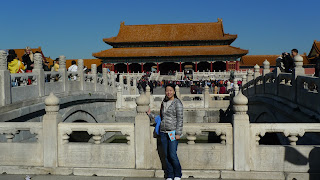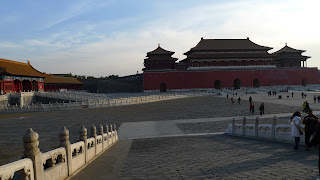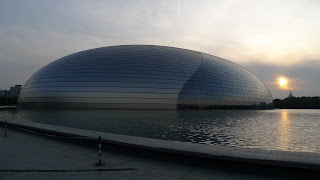After we landed in Beijing, we headed towards the Temple of Heaven, where the emperors from the Ming and Qing Dynasties prayed to heaven for a good harvest.
For our first dinner in Beijing, we decided to try the famous lamb hot pot. We went to Shin Kong Place in the Chaoyang District. Shin Kong Place reminded me a lot of department stores in Japan. The basement floors were filled with stores/stands that sell yummy desserts and other food items and the top floor was full of restaurants. We went to Hot Pot Paradise as recommended by our Beijing guide book. There was a long wait so it took us almost an hour to get a table. We each got our own pot and there were numerous varieties of lamb, mutton, and beef to choose from. The meat was pretty gamey but good thing there was a sesame sauce and lots of chillies to cover the gamey taste.
The next day we had great weather so we headed to Qianmen Station to join a bus tour to go to the Badaling Great Wall and the Ming Tombs. I had read about people getting scammed by joining bus tours in China, so make sure you go to the Beijing Hub of Tour Dispatch or else you may be charged extra when you get on the bus or they may take you to places not specified in the itinerary.
We joined the full day tour and first they took us to the Ming Tombs, which consists of 13 tombs of the Ming Dynasty. As part of this tour, we visited the Dingling (定陵) which is the only tomb that has been excavated.
For the price of $160, this tour included a lunch. As I expected, just before lunch, we were taken to a jade factory where we had to spend time in a show room to look at/purchase different jade products. Along the way, the tour guide had been telling us all kinds of stories about the mythical creature called pixiu (貔貅) and how we should take the chance to bring one home for good luck and fortune, so I'm sure some sort of commission is given to the tour company for any purchases at this jade factory. Lunch was served right upstairs from the jade factory. I couldn't believe how appalling the lunch was. The food seemed really scary and dirty. I'm surprised 2hung was able to sit through the meal. Unfortunately, I didn't take any pictures of the food, but I did not eat any of it!
Next stop was the Badaling Great Wall. Badaling is the most popular section of the Great Wall as it is the most convenient section to get to from Beijing. With the cable car, it is easy to get to the highest point of the Great Wall. Notice the amount of tourists in each of our pictures! Parts of the Great Wall are very very steep so we had to be very careful when climbing it. The feeling that I got once we climbed to the top was surreal. I couldn't believe that I was physically standing in such a magnificent structure that was built thousands of years ago. I think the next time we visit Beijing, we would choose to go to a less crowded section of the Great Wall and we would consider taking public transportation there so that we can spend more time climbing the Wall.
We arrived back in Beijing in the early evening, so we went to Wang Fu Jing Da Jie to look for something to eat. We were trying to look for a Szechuan restaurant that was recommended by our guide book, but it seemed to have closed down so we decided to settle for another restaurant that was also in the guide book which served local Beijing food. I guess this was not a good day for us in terms of food, as the restaurant seemed kind of dirty and the food wasn't very good. One of the workers behind the bar had apparently been drinking and starting waving knives around, so we got out of there as soon as we could. There are a few streets that sell a lot of street food in Wang Fu Jing, but again we were too scared to eat the food from there because we thought that it might be dirty. If you are into sea horses, starfish, scorpions or other bugs, this is the place for you!
Check out the live scorpions, ready to be grilled to your liking!
The next day, we visited Tiananmen Square and the Forbidden City. We actually went to Tiananmen Square multiple times during the morning, afternoon and evening. This is one of the largest city squares in the world and where the 1989 protests took place.
It takes about the whole day to explore the Forbidden City. After leaving the Forbidden City, we walked over to the contemporary National Centre for the Performing Arts which is a huge contrast to the ancient palace.
On our last night in Beijing, we went to the Quan Ju De for some Peking duck. Quan Ju De is the most famous Peking duck restaurant in China and we went to the founding restaurant on the revamped Quianmen St. to get a ticket for a table at around 5:30pm. The night before we walked by the restaurant at around 6:30pm and the restaurant had already given away all tickets, so we were sure to arrive bright and early this time. The duck was very professionally sliced by each of the chefs by your table. We ordered half a duck and some side dishes. Surprisingly, I didn't find the duck to be too fatty. The pancakes were very thin, the dipping sauce was rich, and the skin of the duck was nice and crispy.
On our last day in Beijing, we took it easy and visited the Olympic stadiums in the morning.
We then took lunch at the Noodle Bar inside 1949 - The Hidden City. From what I read, this is an expats' hangout.
Before heading to the airport, we took one more stop to see the hutongs in Nan Luo Gu Xian.
This street is now filled with shops and cafes. We didn't choose to
hire a pedicab to tour the hutongs because we thought it'd probably be a
ripoff, so we just explored the area on foot.

















































No comments:
Post a Comment